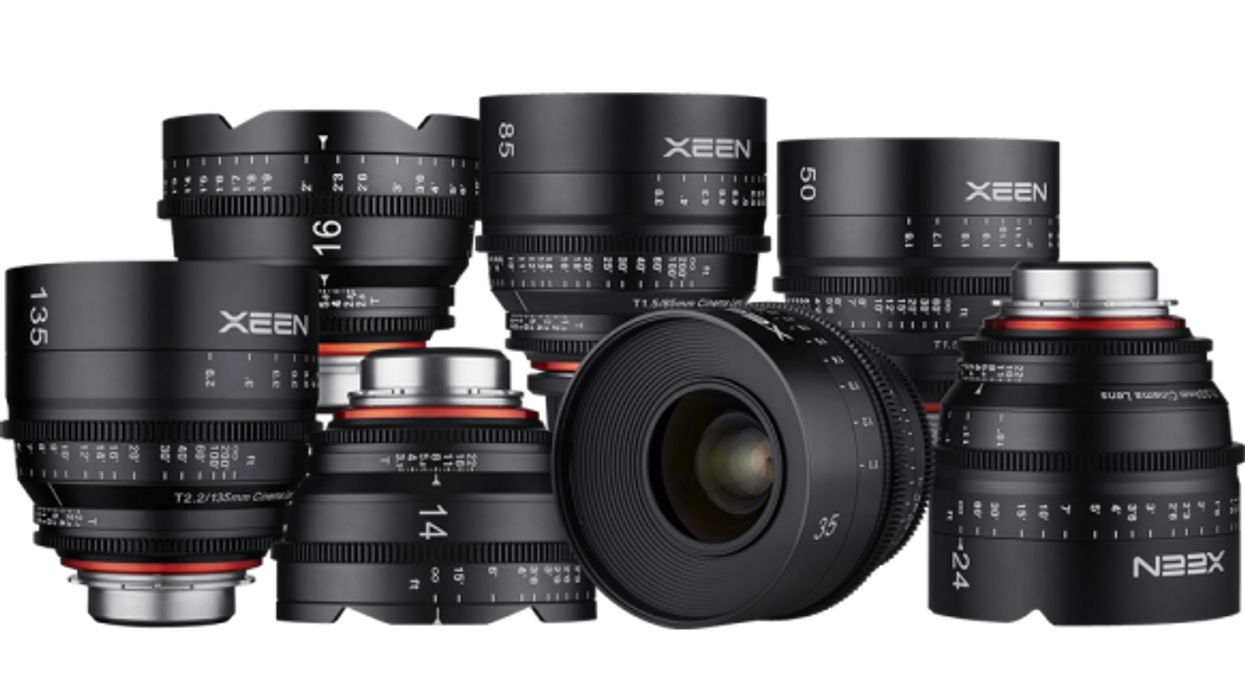XEEN 16mm Completes the Samyang Cinema Lens Line
Samyang has completed its XEEN line of cinema lenses with the T2.6 16mm lens, available in PL, EF, Nikon, MFT and Sony E mounts.

Samyang has finally competed the release of its XEEN line of cinema primes with the 16mm T2.6, hinted at in teaser images over the summer. The XEEN line, based on the older Samyang VDSLR line, has generated some excitement and promises to offer impressive performance considering the price. With a list price under $2500, and street prices regularly coming in around $2200, the XEEN line offers traditional cinema lens features like consistent front element size (114mm) and focus/aperture ring placement for fast lens swaps, 200° focus rotation for precise focusing, internal focus for no lens length change (so the front element won't hit your matte box), and of course the swappable lens mount. While it can't be done in the field and requires a trip to a lens tech, lenses that can be changed between five popular mounts are a smart investment that could likely be of reliable service for many years to come.

We made some guesses when the lens was first teased, primarily that the missing lens in the line would be based on the Rokinon 16mm T2.2 model. However, Samyang states that this is a new design and not based on the Rokinon, which makes sense since the previous lens only covered Super 35mm, and this lens offers Full Frame coverage. That being said, the final specs of the lens are something of a disappointment, especially for a brand new design.
The main line of lenses in the series—from 24mm to 85mm—open to a T1.5, which is just a bit stopped down from a 1.4, long the gold standard of "wide aperture" on a lens. At the long end of the spectrum, the 135mm only opens to a 2.2, but that's only around one stop slower than the rest of the line, and at the longer end of things it's generally alright to stop down a bit and accept the extra depth of field that comes with it. If you are WFO (wide freaking open) on a 135mm, your depth of field is likely tiny, and having a little extra room to help the focus puller is often appreciated. It's also physically more complicated to design a wide aperture long lens, as aperture is the relationship of the length to the width of the lens, and long lenses have to be physically much wider to make a long lens that opens wide.

The new lens is only 2/3 of a stop faster than the widest in the range (the 14mm T3.5), leaving the new 16mm slightly more than 1 1/3 stops slower than the rest of the line with their T1.5 apertures. This 1 1/3 stop would still keep this lens from being in the regular rotation, since a consistent aperture is such a key part of a cine lens line. Cinematographers are generally lighting a scene to a specific aperture, and if the majority of your lenses open to a T1.5, the trade off of extra light volume and time to light to a T2.6 for only your widest lens won't always be worth it.
Considering the field of view of the 24mm XEEN at Full Frame is 84°, the equivalent of a 14mm lens on Super35mm, many Full Frame filmmakers will likely not feel the need to go for the wider, slower glass. This slow aperture is especially frustrating if you are going for a shallower depth of field look, as you'll want wider apertures more at the wide end of the range than you might at the long end.
There are always sacrifices that come with such affordable lenses, but considering how similar in field of view the 16mm is to the 14mm (115° vs 107° at full frame, only 7.5% difference), it seems unlikely that many users will want to purchase both, if they purchase either. This is a trade off a lot of manufacturers have made. The Zeiss CP2 15mm only opens to a T2.9, and the Schneider Xenon 18mm (twice the price of the XEEN) only manages a 2.4, but those are from lens sets that are overall slower, with both lines mostly opening to a 2.1. It seems likely that Samyang wanted to keep the pricing consistent throughout the line, and sacrificed a consistent aperture to keep the price in line with its stablemates, but I think they would have been smart to have gone for a higher price and a consistent aperture. Master Primes charge more ($21000 vs $27000, a 28% markup) for a consistent aperture on their widest glass, but it makes for a more useable set. I think users would've likely eaten a markup here for a wider aperture wide lens.
What do you think, is this is the perfect lens to complete the XEEN set? Or not quite what you were hoping for?
Available December 2016.
Tech specs:
- 114mm Front Diameter
- Aluminum Housing
- Consistent Focus/Aperture ring placement
- Internal Focus (non-rotating front element)
- Covers Full Frame 35mm/8K VistaVision (RED)
- Mounts: PL, Canon EF, Nikon F, Sony E, Micro 4/3
- Available in Metric or Imperial Measurement
- 200° focus rotation
- 11 Blade Iris
- T2.6 maximum aperture
- 3-year limited warranty (voided if self-service lens mount change)















